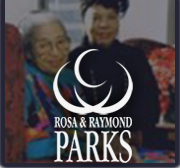****PATHWAYS TO FREEDOM****
The Rosa and Raymond Parks Institute and Staff are proud to be a part of the organization that Mrs. Parks co-founded in 1987 to carry on her work. Led by Elaine Eason Steele, co-founder, we are determined to continue what Mrs. Parks started when she was working with youth as a volunteer of the NAACP long before the act of courage that propelled her into the public eye. The history of the Institute, and its accomplishments are interwoven with Mrs. Parks’ life as a civil rights leader, a world icon, and a private citizen.
Our central mission is to motivate youth to reach their highest potential. We have designed programs based on Mrs. Parks philosophy of “Quiet Strength” which engages youth in hands-on experiences to build practical day-to-day living skills. We promote multicultural participation in our program to provide youth with a cross-cultural exposure for nurturing a global and inclusive perspective.
2007 Pathways To Freedom program video. Taped, edited and produced entirely by the students.
Pathways to Freedom, the core program, traces the underground railroad into the civil rights movement and beyond. It is supported by extended curriculum components implemented throughout the year within local communities. Pathways Chapters are in seven other states in the U.S. as well as the Bahamas and Canada. Students, traveling primarily by bus, experience a unique historical research journey and learn lessons of history from interpersonal interaction and hands-on activities. Pathways brings the history of the civil rights movement to life and empowers youth with the skills to model Mrs. Parks’ work for human rights in all areas. Over a five-week period each summer, the program covers regional, national and international territory and culminates in a creative finale reporting on the learning expedition. Mrs. Parks traditionally met and encouraged the students during the Regional program which has always been held in Michigan. They share their knowledge and experiences in public forums in their local communities after returning home.
Our Learning Centers, in Michigan and California, utilize an intergeneration model of youth mentoring seniors in the acquisition of basic computer literacy. Mrs. Parks was a graduate of the first class in 1997. Senior citizens demonstrate increased motor activity and motivation to learn. They exchange important wisdom messages about their life experience as a part of the interactive relationship with youth.
In response to the events of September 11th, the Rosa Parks Institute moved to action to promote healing among young people. In order to have broader outreach we initiated collaboration with The Boggs Center for Community Leadership and Wayne State University’s Multicultural Experience in Leadership Development Program. The three organizations had common interests in leadership development, multicultural particiapation and action planning. A Youth Peace Summit series was designed as a commemoration to the model of peaceful protest demonstrated throughout the Montgomery Bus Boycott. The historical contributions of Dr. Rosa Parks and Dr. Grace Boggs as humanitarians were driving forces to the planning. The main emphasis was focused on lifting the voices of youth in expressing feelings and solutions. Most powerful was hearing the testimonies of the contingency of young people who had experienced war (from Sudan, Bosnia, Kosovo, Argentina and El Salvador). The dialogue was informative, deeply moving and exciting. In small self-selected groups, the students articulated their thoughts on ways to promote peace, then expressed their vision of peace through several creative modalities: dance, art, poetry, photograpy, drama, storytelling and journalism.
Part two engaged students in further dialogue by reviewing how media influences peace. The discussion identified the youth’s unique perspectives on messages of violence, stereotypes and hate communicated in three groupings: 1) print and the internet; 2) music; and 3) television and radio (including news reporting and commercials).
Part three of the series connected the young people to the global community via the United Nations Youth Assembly. Using Mrs. Parks as an example, students were encouraged to make a connection between their personal behavior and their capacity to make worldwide impact. After participating in a confict resolution workshop, they brainstormed ideas and made a commitment to one action they would take for creating peace on an individual basis. The group agreed to convene local “Greet Your Neighbor” events to promote neighbor-to-neighbor education about the need for peace. The Rosa & Raymond Parks Institute has committed to continue its Youth Leadership Peace Initiative by promoting Youth for Peace Action activities.
We are proud of the life transformations that have occurred in the lives of the thousands of students who have participated in the Institute’s programs over the past sixteen years. In the past several years our staff and leadership roles have included students who have participated as “National Freedom Riders.” Some examples of the evidence of the impact of the program, as most frequently reported by the students, parents, or schools include: increased focus and self-discipline; returning to school from a drop-out status; completion of high school; volunteer service to
